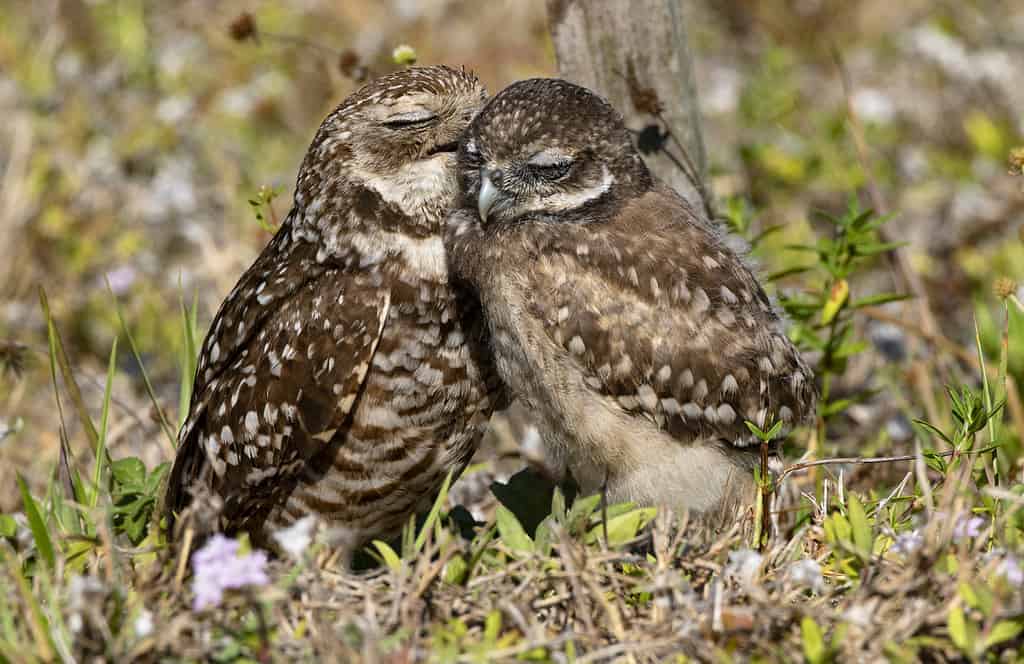Owls are any of the 248 bird species in the Strigiformes order. Within this order, the larger Strigidae family contains 228 species known as the typical owls, while the smaller Tytonidae family includes 20 species of barn owls and their relatives (grass owls, masked owls, and bay owls). Although there is no single factor beyond the basics of reproductive anatomy and egg-laying that distinguishes all males and females in every owl species, there are some differences that are common and widespread, as well as some that have been documented for certain species. Read on to find out five key differences between male and female owls!
1. Male vs. Female Owls: Size and Weight

Female owls are often a little bigger and heavier than males — can you tell who is who in this
barred owl (Strix varia)
pair?
©Matthew Paulson / CC BY-NC-ND 2.0 DEED – Original / License
Sexual dimorphism is when males and females of the same species exhibit easily distinguishable outer body traits. Examples include differences in size, weight, shape, color, ornamentation, and so on. As with other birds of prey, female owls are, on average, a bit bigger and heavier than males in many species. For instance, in tawny owls (Strix aluco), females are 20-40% heavier and have a wingspan that is 5-10% longer than males. Of course, this trait is usually only readily obvious when the male and female are right next to each other! Furthermore, there are exceptions to this general rule. For example, when it comes to the largest owl species in Australia, the powerful owl (Ninox strenua), the male is typically the bigger of the pair.
Male vs. Female Owls: Color

The
snowy owl (Bubo scandiacus)
is one of the few owl species with significant dichromatism, with mature males usually noticeably whiter overall with fewer markings.
©Tambako The Jaguar / CC BY-ND 2.0 DEED – Original / License
In addition to differences in size and weight, there are also coloration differences (dichromatism) in some owl species. In many of these cases, however, the differences are subtle. For example, plumage and/or bare parts may appear slightly darker or lighter in one sex, or they may have different shades of eye color. For example, in barn owls (Tyto alba), males are generally paler and females darker overall, with females also more heavily spotted.
Male vs Female Owls: Vocalizations

In
burrowing owl
(
Athene cunicularia) pairs, the female tends to call in a slightly higher pitch.
©Florence and Joseph McGinn/iStock via Getty Images
Owls are vocal creatures, and each species has their own unique suite of calls. In at least some of these species, differences in male and female calls have been recorded. The most commonly reported difference is that the males tend to call at a lower pitch than females.
Male vs Female Owls: Courtship Behavior
Most owls form strong pair bonds, though whether these last for just the breeding season or a lifetime varies by species. Every species has its own courtship ritual, with the males and females each playing their roles. In general, though, a male will call from his territory, an interested female will respond, and then the male will try to win her favor. This may involve anything from displaying feathers to performing sky dances to offering food gifts! Additionally, it is common for males to establish a territory but for females to select the specific nest site.
Male vs. Female Owls: Parental Care

Females are both the only egg-layers and the only egg-sitters, like this female eastern screech owl (
Megascops asio) with her clutch.
©LagunaticPhoto/iStock via Getty Images
The only 100% reliable way to tell male and female owls apart, at least on the outside, is to see who has the eggs! Obviously, females are the ones who actually lay the eggs. In addition, females remain in the nest as the sole incubators of these eggs. Once the eggs hatch, the most common parental strategy is for the female to continue brooding the nestlings while the male does the majority of the hunting for the family. As the nestlings get older, however, the female may begin going out on hunting excursions as well.
Summary of Male vs Female Owls: 5 Key Differences
| Trait | Differences |
|---|---|
| size and weight | females are usually a bit larger and heavier (most species) |
| color | differences in plumage, bare parts, and/or eye color (some species, usually subtle) |
| vocalizations | differences in calls, e.g. males with lower pitch/females with higher pitch (some species) |
| courtship behavior | males call, females respond, then males perform (most species) |
| parental care | females are sole layers and incubators of eggs (all species); females do the majority of brooding of nestlings while males do the majority of hunting for family (most species) |
The photo featured at the top of this post is © Hanafi Zul Afkar/Shutterstock.com
Thank you for reading! Have some feedback for us? Contact the AZ Animals editorial team.







